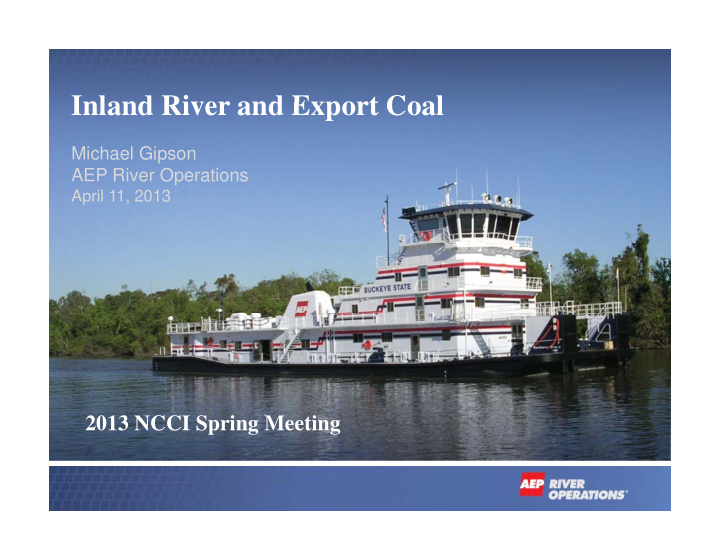



Inland River and Export Coal Inland River and Export Coal Michael Gipson AEP River Operations AEP River Operations April 11, 2013 2013 NCCI Spring Meeting
One of the Nation’s Leading Barge Companies AEP River Operations is a fully-integrated barge line that delivers over 74 million tons of dry cargo for our customers each year. AEP River Operations’ fleet of boats and barges operate from all along the Gulf Coast to as far north as Minneapolis, Chicago, Milwaukee, and Pittsburgh. Mi li Chi Mil k d Pitt b h AEP entrusts AEP River Operations to manage its coal and AEP t t AEP Ri O ti t it l d consumable supply chain to its power generation fleet on the Ohio River. 2
Strategically Located Full-Service Inland W t Waterways Carrier C i St. Louis, Missouri Headquarters St. Louis, Missouri Headquarters •~1,400 employees Full-service Inland Waterways carrier •3,263 hopper barges 3, 63 oppe ba ges •60 towboats •27 fleet and shuttle boats Regional Operations •Pittsburgh PA – Sales & Customer Service •Pittsburgh, PA – Sales & Customer Service •New Orleans, LA – Sales & Operations •Lakin, WV – Boat & Barge Operations •Paducah, KY – Boat & Barge Operations •Mobile, AL – Sales & Customer Service Gulf Operations •Full Service Shipyard •Barge cleaning and repair •Fleeting and shifting •Midstream transfers 3
Convent Operations Convent Fleet Operations and dispatch center • Permitted to hold 650 barges • Operating 11 harbor tugs, 3 shuttle boats and • two dry docks two dry docks 36 barges/day wash dock capacity • Import loading location • Mid-stream ship-to-barge and barge-to-ship p g g p • capabilities State of the Art Training Facility: • Deckhand training center • Dormitory space for 70 employees 4
One of the Largest River Carriers • Broad range of towboat classes • Operate 60 towboats and 27 tugs • We augment our fleet when needed with well-established charter & towing partners. 5
Boat Fleet Safety, Reliability, Effi i Efficiency, & Comfort & C f t Our Boats are designed to g meet our customers needs. Reduced emissions by 40% Reduced emissions by 40% Increased reliability, fewer repair-related delays Decreased fuel consumption by 15% Advanced safety features d a ced sa ety eatu es Increased amenities for maximum crew comfort 6
U. S. Inland Waterways System About 600 million tons of About 600 million tons of cargo move each year on the cargo move each year on the U.S. inland waterways, most U.S. inland waterways, most of it in bulk of it in bulk of it in bulk. of it in bulk. L Lock & Dam Sites k & D Si
AEP River Operations One of America’s largest dry cargo carriers Approximately 75 million tons pp y shipped in 2012
The Inland Waterways are the most cost effective means of transporting bulk effective means of transporting bulk commodities The average cost savings of In 2010 our Inland Waterways $11.00/ton, when compared to system moved close to 600 rail and truck, means the Inland million tons of freight valued at million tons of freight valued at Waterways System saved the Waterways System saved the more than $180 billion. nation ~ $6 Billion in transportation costs in 2010! 9
Safest Means of Transporting Bulk Commodities For each injury involving barge transportation, there are 95 1.0 1.0 injuries related to rail and j 1,609 truck-related injuries. 95.3 95.3 1,609.6 1,609.6 10
Drought of 2012 Drought of 2012
12
Drought Impact on River Transportation: Pure Economics Normal Conditions Normal Conditions Low Water Conditions Low Water Conditions Barge Draft = 12’ Barge Draft = 9’ Barge Tons = 2,100 Barge Tons = 1,452 Barges per Tow = 40 Barges per Tow = 40 Barges per Tow = 25 Barges per Tow = 25 40 x 2,100 = 84,000 tons per tow 25 x 1,452 = 36,300 tons per tow $14.00 per net ton rate would be a $667,800 difference per tow $ , p 13
Drought Impact on River Transportation Boats move more slowly: 50 Boats move more slowly: 50 miles per day vs. 200 miles per day Delays for passing through narrowed channels (one way traffic) Lost nearly 200 boat days to river closures in August and September September Increased barge maintenance costs costs
15 Lower Mississippi River
Mississippi River Shut Down November 2012 Upper Missouri November 2012 Upper Missouri River reservoirs are low, so USCOE stops river flow Anticipation of water levels would Anticipation of water levels would drop below 9’ draft the first part of December Rock removal at mile 78 and mile Rock removal at mile 78 and mile 46 (Rock Pinnacles), possible complete late Feb. 2013 Industry concerns of halting barge Industry concerns of halting barge traffic, divert tonnage to Ohio River
US Export Coal 2010 - 2012 p
US Export Coal US Export Coal • • Companies continue to Companies continue to invest large sums to increase the Gulf capacity for export coal • As the East Coast begins to increase tonnage and tightens capacity opens up door capacity, opens up door for export out of Gulf. • As the European markets began to markets began to recover, with high gas prices, US coal demand should remain high. 18
Global Demand to Grow Global Demand to Grow • China and India will continue with strong growth which increases their demand for coal • Gas prices in Europe and global demand, will continue high demand for US Coal • Several believe the Panama Canal expansion will increase tons through the Gulf for Asian market and Mexico. Source: U.S. EIA OECD – Organization for Economic Cooperation and Development 19
Mi h Michael Gipson l Gi Sales Representative Office – (636) 530-2441 mbgipson@aepriverops.com g p @ p p
Recommend
More recommend